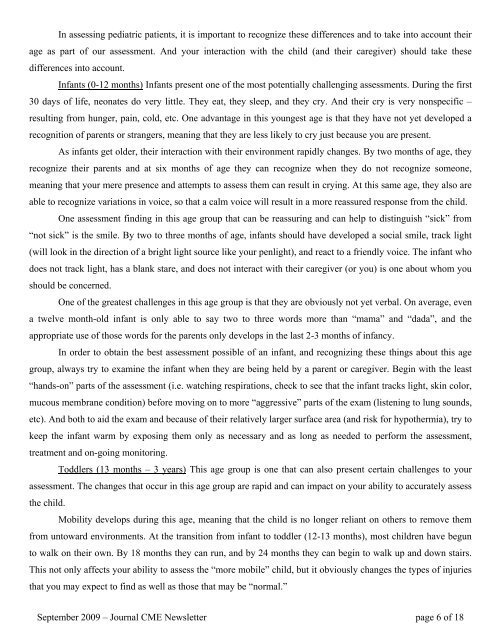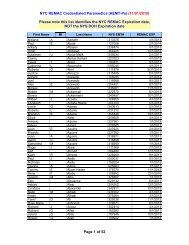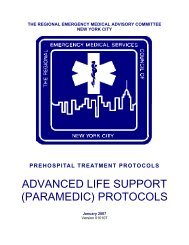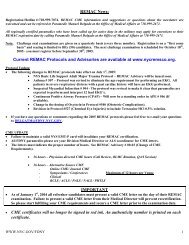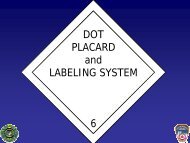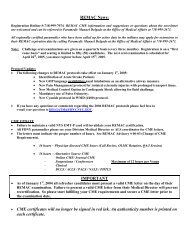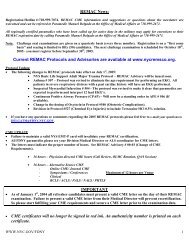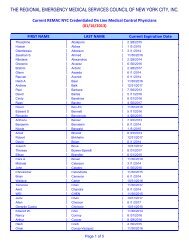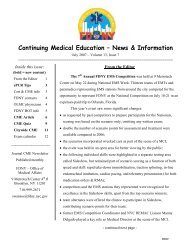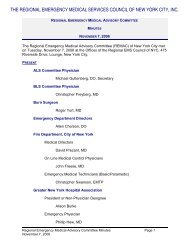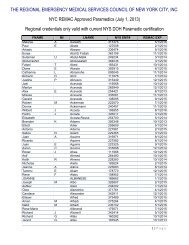Continuing Medical Education - News & Information - The Regional ...
Continuing Medical Education - News & Information - The Regional ...
Continuing Medical Education - News & Information - The Regional ...
You also want an ePaper? Increase the reach of your titles
YUMPU automatically turns print PDFs into web optimized ePapers that Google loves.
In assessing pediatric patients, it is important to recognize these differences and to take into account theirage as part of our assessment. And your interaction with the child (and their caregiver) should take thesedifferences into account.Infants (0-12 months) Infants present one of the most potentially challenging assessments. During the first30 days of life, neonates do very little. <strong>The</strong>y eat, they sleep, and they cry. And their cry is very nonspecific –resulting from hunger, pain, cold, etc. One advantage in this youngest age is that they have not yet developed arecognition of parents or strangers, meaning that they are less likely to cry just because you are present.As infants get older, their interaction with their environment rapidly changes. By two months of age, theyrecognize their parents and at six months of age they can recognize when they do not recognize someone,meaning that your mere presence and attempts to assess them can result in crying. At this same age, they also areable to recognize variations in voice, so that a calm voice will result in a more reassured response from the child.One assessment finding in this age group that can be reassuring and can help to distinguish “sick” from“not sick” is the smile. By two to three months of age, infants should have developed a social smile, track light(will look in the direction of a bright light source like your penlight), and react to a friendly voice. <strong>The</strong> infant whodoes not track light, has a blank stare, and does not interact with their caregiver (or you) is one about whom youshould be concerned.One of the greatest challenges in this age group is that they are obviously not yet verbal. On average, evena twelve month-old infant is only able to say two to three words more than “mama” and “dada”, and theappropriate use of those words for the parents only develops in the last 2-3 months of infancy.In order to obtain the best assessment possible of an infant, and recognizing these things about this agegroup, always try to examine the infant when they are being held by a parent or caregiver. Begin with the least“hands-on” parts of the assessment (i.e. watching respirations, check to see that the infant tracks light, skin color,mucous membrane condition) before moving on to more “aggressive” parts of the exam (listening to lung sounds,etc). And both to aid the exam and because of their relatively larger surface area (and risk for hypothermia), try tokeep the infant warm by exposing them only as necessary and as long as needed to perform the assessment,treatment and on-going monitoring.Toddlers (13 months – 3 years) This age group is one that can also present certain challenges to yourassessment. <strong>The</strong> changes that occur in this age group are rapid and can impact on your ability to accurately assessthe child.Mobility develops during this age, meaning that the child is no longer reliant on others to remove themfrom untoward environments. At the transition from infant to toddler (12-13 months), most children have begunto walk on their own. By 18 months they can run, and by 24 months they can begin to walk up and down stairs.This not only affects your ability to assess the “more mobile” child, but it obviously changes the types of injuriesthat you may expect to find as well as those that may be “normal.”September 2009 – Journal CME <strong>News</strong>letter page 6 of 18


